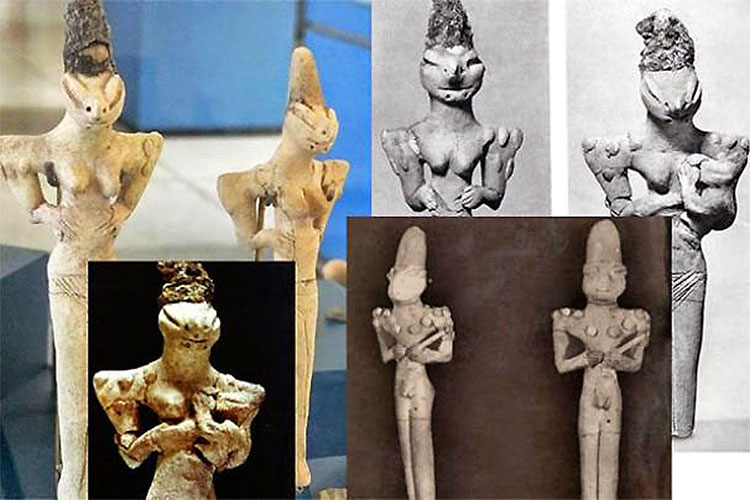The thousand-year mystery of a lizard-man statue with a 'deformed' face
It is a commonly accepted view in mainstream archaeology that civilization began in ancient Mesopotamia with the great civilization of Sumer in what is now present-day Iraq. However, in the early 20th century, archaeologists excavating at Tell Al'Ubaid in Iraq made an unusual discovery when they unearthed a number of 7,000-year-old artifacts representing human figures with distinctive features. point of the reptile.
One of the world's most difficult to solve are the Ubaid lizard people found in Iraq. These ancient statues have human faces but have many similarities with lizards.
Archaeologists have found a number of statues in Iraq, mainly at Tell Al'Ubaid, Ur and Eridu. According to experts, these statues belong to the pre-Sumerian civilization - the Ubaid.

These statues have human faces but have many similarities with lizards.
The Ubaid period lasted from 5,900 - 4,000 BC. The reason these statues attract the attention of experts and the public is because of their shape.
The Ubaidian culture is a prehistoric culture in Mesopotamia dating from 4000 to 5500 BC. To the Sumerians, the origin of the Ubaidians remained a mystery. They lived in large village settlements in mud-brick houses and they developed architecture, agriculture, and farming on the land using irrigation.
Ubaidian domestic architecture includes large T-shaped houses with large courtyards, paved streets, as well as food processing facilities. According to the Metropolitan Museum of Art, some of these villages began to develop into towns, temples began to appear, as well as monumental structures such as those at Eridu, Ur and Uruk, sites core of the Sumerian civilization. Sumerian texts explain that Ur is believed to be the first city.
Specifically, the statues found at Tell Al'Ubaid, Ur and Eridu all have in common that they have human faces but have many similarities with lizards. All the statues are in pose and without much frills. Some experts say these statues are not like the statues of gods with the head of animals like ancient Rome or Egypt.
Other figurines were found holding a scepter or scepter, possibly a symbol of justice and rule. Each statue has a different pose, but the strangest are some of the statues of women holding a nursing baby, with the child being shown as a lizard-like creature.
One view is that these statues depict a little known race of lizard people. There is even a theory that these statues depict aliens in the form of lizards. However, there is also a view that the Ubaid people used to practice the practice of deforming the skull. This may have caused their heads to have lizard-like features.

Lactating naked woman with lizard head, from Ur, Iraq, c. 4000 years BC, present Iraq Museum.
The statues are presented with long heads, almond-shaped eyes, elongated faces and lizard-like noses. Exactly what they represent is completely unknown. According to archaeologists, their poses, such as that of a woman nursing a baby, do not suggest that they were ceremonial objects. So what do these Ubaid lizard people represent?
Whatever they were, they seemed to be very important to the ancient Ubaidians. We know that the snake was a major symbol used in many societies to represent certain deities, such as the Sumerian god Enki, and that the snake was later used as a symbol for the Brotherhood of the Snake, believed to be an ancient secret society. Is there any connection between the symbolism of the snake and the symbolism of the lizard? Currently, these questions remain unanswered.
So far, the scientific community has not been able to decipher the secret of the 7,000-year-old lizard-man statues with a peculiar head.
- The special status of a man whose face is the prototype of the Statue of Liberty
- The mystery of the Buddha statue of But Thap temple
- Detecting debris from a 40-thousand-year-old mammoth ivory statue
- Successful surgery of the deformed face completely
- The mystery of the human face
- The oldest statue in the world and the mystery yet to be solved
- Mexico: Lizard discovered 23 million years old
- Discovered a 2,000-year-old metal god statue of Celts
- The 23,000-year-old love idol statue has a beautiful beauty
- 200 million-year-old sea lizard fossils discovered
- Digging soil to detect a 1000 year old god statue
- The mystery of the 2,000-year-old dog head statue buried under the road surface: the entrance to the 'world of the dead'
 The truth about the mysterious red-haired giant at Lovelock Cave
The truth about the mysterious red-haired giant at Lovelock Cave Inunaki Tunnel: The haunted road leading into Japan's 'village of death'
Inunaki Tunnel: The haunted road leading into Japan's 'village of death' The mystery of the phenomenon of human reflection before dying
The mystery of the phenomenon of human reflection before dying 6 mysterious phenomena, although science has been developed for a long time, still cannot be answered
6 mysterious phenomena, although science has been developed for a long time, still cannot be answered